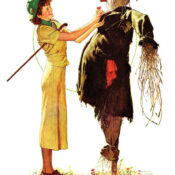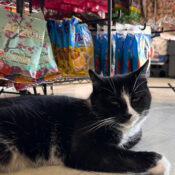- Madeleine’s wild on-stage antics were a sharp contrast to her normal ______ demeanor, …
- straight-laced
- strait-laced
- strate-laced
- …but her slapstick comedy act was nonpareil — it was
- unmatched.
- not at all funny.
- amateurish.
- Madeleine likes silhouettes but not outlines, magnolias but not dogwoods, and mesmerism but not hypnotism. What does Madeleine like?
Answers and Explanations
1. b. strait-laced
It’s a common mistake to write straight-laced when, in fact, the idiom is strait-laced. Strait, which derives from the Latin strictus, means “narrow, constricted.” As an adjective, it’s an archaic word that today exists almost exclusively in two phrases: in straitjacket, a garment designed to be extremely constrictive; and in the idiom at hand, strait-laced, which means “strict or conservative in morality or behavior.”
The confusion is easy to understand. You might consider someone who is strait-laced to be on the straight and narrow, and conflation of the two would lead to straight-laced. But also consider: You can’t lace up something — shoes, a girdle, a straitjacket — and still keep the laces straight.
As a noun, strait is less archaic; you can find it on many maps. This type of strait is a narrow waterway between two larger bodies of water — and again the idea of constriction is evident here.
2. a. unmatched
It probably comes as no surprise that nonpareil came to English through French — in this case, Middle French. It derives from a Vulgar Latin form of the word par, meaning “equal” (think on par with). Nonpareil, then, means “having no equal,” or “unmatched.”
Nonpareil is also a little round chocolate covered in sugar.
3. Madeleine likes eponyms, words named after people.
- Silhouette comes from Étienne de Silhouette, France’s finance minister under King Louis XV, who, as a hobby, enjoyed cutting profile portraits from paper.
- Magnolias were named for French botanist Pierre Magnol, who devised the system for classifying plant species.
- Mesmerism derives from the surname of Franz Anton Mesmer, an Austrian physician who devised a theory about a mysterious bodily fluid that allowed one person to hypnotize another.
Eponyms abound in English, and they aren’t always obvious. You probably recognize boycott and gerrymander as eponyms, but so are chauvinist, diesel, leotard, and ritz. So is madeleine, the small, shell-shaped cakes; they’re believed to be named for Madeleine Paulmier, the 19th-century pastry cook who is thought to have invented them.
—Andy Hollandbeck is the Post’s copy editor and managing editor.
This article is featured in the July/August 2019 issue of The Saturday Evening Post. Subscribe to the magazine for more art, inspiring stories, fiction, humor, and features from our archives.
Featured image: Shutterstock
Become a Saturday Evening Post member and enjoy unlimited access. Subscribe now




Comments
I always thought the dogwood tree was named after Dogwood Bumstead
I knew #1 couldn’t have been ‘c’, but thought it was ‘a’. I had no idea on numbers 2 and 3. I hope this doesn’t put your opinion of me in dire straits.